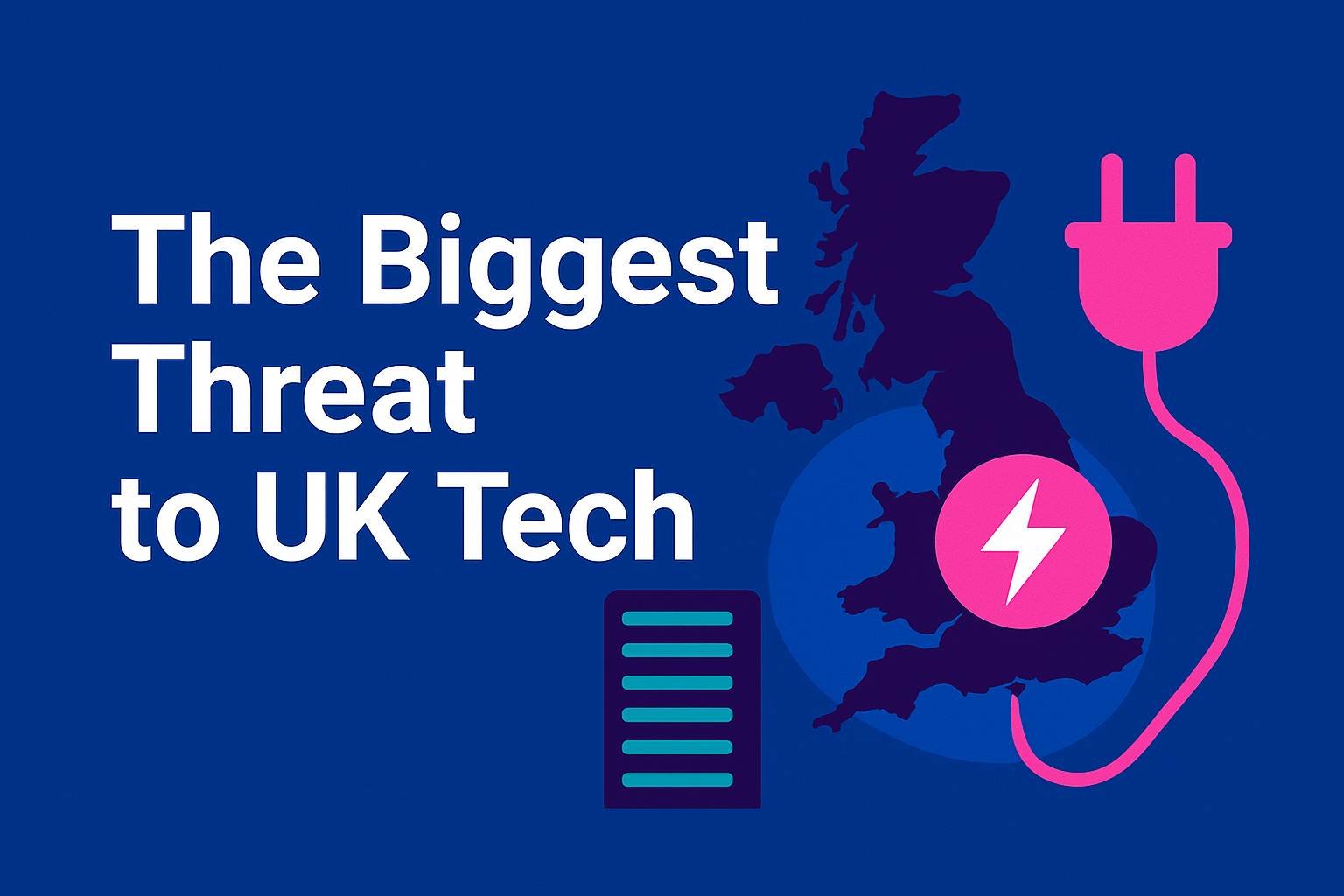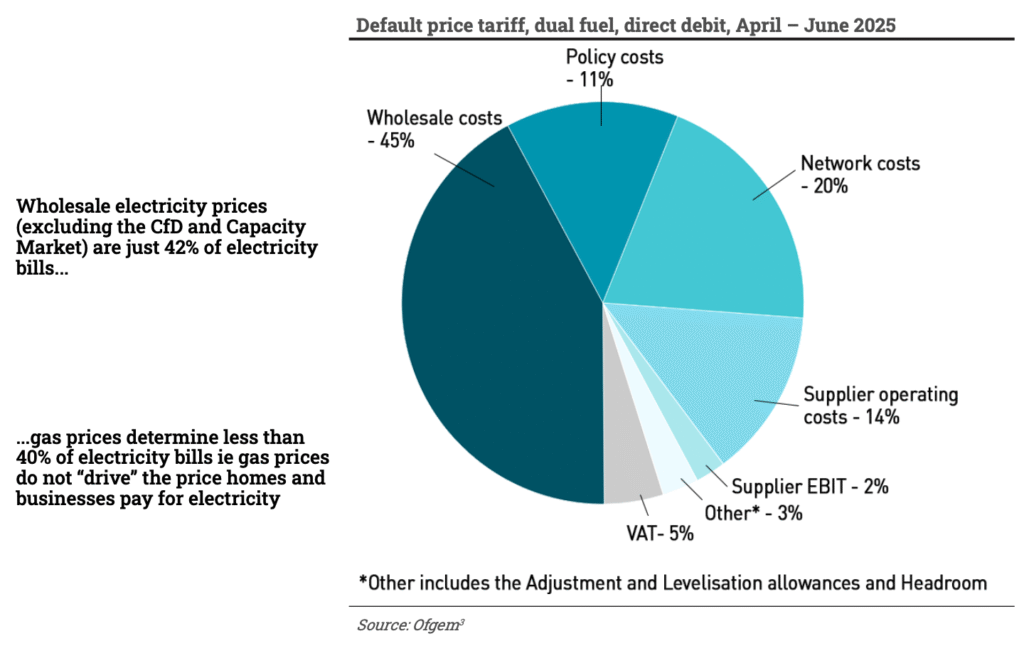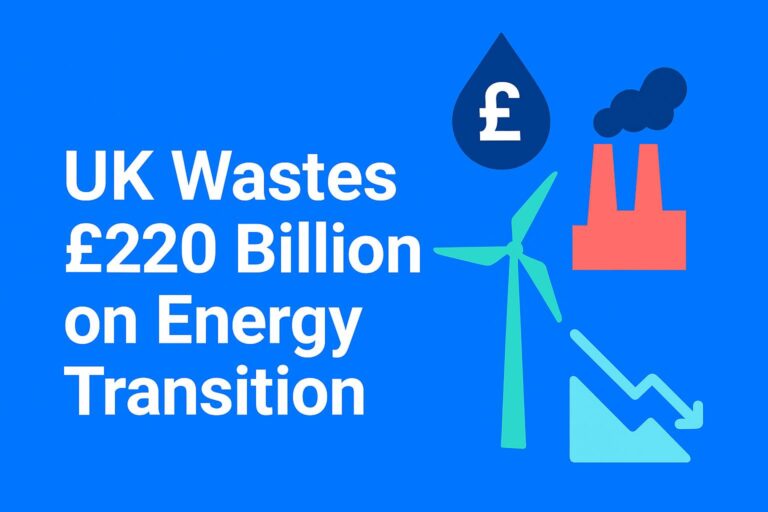How Energy Costs Could Derail the UK’s Tech and AI Ambitions…
The UK’s high electricity prices and infrastructure challenges pose a significant threat to tech sector. The UK Government’s pursuit of Net Zero and the energy transition is a huge drag on the economy, at a time when growth is desperately needed, but they seem not to be listening, understanding or caring. The UK tech sector stands at a crossroads, as artificial intelligence (AI) drives unprecedented demand for computing power and data centre capacity. The industry faces a fundamental challenge that could determine whether Britain remains competitive in the global technology race or falls behind its international rivals.

The Energy Own Goal
Tech firms used to worry about things like talent, innovation and investment, but now it’s about all those things plus the desperate need for reliable and affordable electricity. There isn’t an economy in the world capable of growth without a reliable energy supply that is priced to promote industrial and commercial activity. As the Western world de-industrialises and seeks to digitise its economies, there is a desperate need for more energy, not less, for stability in the power generation and electricity grid system, not less, and for more competitive pricing, not the most expensive industrial electricity in the world. The numbers tell a stark story that should concern every tech leader and policymaker in the country. While the UK has tried to position itself as a global leader in AI research and financial technology, the underlying energy infrastructure that powers these innovations is becoming increasingly uncompetitive on the world stage.
AI Energy Demand
The AI boom has the propensity to reshape global electricity demand. According to the International Energy Agency’s (IEA) central scenario for data centre growth, the sector’s global electricity consumption would more than double between 2024 and 2030, reaching 945 terawatt-hours (TWh) by the end of the decade. This is equivalent to the current electricity demand of Japan. The scale of energy consumption for AI operations is staggering and growing rapidly. Training large language models requires enormous computational power, with some estimates suggesting that training a single advanced AI model can consume as much electricity as several thousand homes use in a year.
Turning Inward Investment Away
As AI models become more sophisticated and training datasets grow larger, these energy requirements are only expected to increase exponentially. This growth trajectory means that countries with competitive electricity prices will have a significant advantage in attracting AI infrastructure investments. Companies making decisions about where to locate their next data centre or AI training facility will inevitably consider the reliability of the electricity supply and the costs as a primary factor. The energy question will potentially be one of the main factors determining the geographic distribution of the next generation of technological innovation. Just as manufacturing and other energy-intensive industries are migrating from the UK to low-cost countries in East Asia, the state of the UK energy market is now a barrier to future inward investments for some of the most important technologies of the future.
The UK’s Energy Price Challenge
The UK’s position in international electricity price comparisons presents a significant challenge for the tech sector. Since 2021, the average electricity price has risen dramatically, with current prices still 75% higher than the average price at the start of 2021. While prices have fallen from their peak, electricity prices in Great Britain amounted to 89 British pounds per megawatt-hour in October 2024, which remains high by international standards. The impact on industrial competitiveness is measurable and concerning. According to the Institute of Economic Affairs, the UK has become “number one in unaffordable electricity” based on international energy price comparisons published by the Government. It can be no surprise that this represents a fundamental competitive disadvantage for energy-intensive industries, including the tech sector’s growing AI and data centre operations.
Unsustainable Energy
The price differential becomes particularly pronounced when compared to major tech hubs. While European prices remain elevated, countries like the United States continue to enjoy significantly lower electricity prices, creating an economic incentive for companies to locate operations outside the UK. For data centre operators, electricity typically represents 60-70% of total operating costs, making price differentials between countries a decisive factor in location decisions. A facility that might cost £10 million annually to operate in the UK could potentially cost £6-7 million in a country with more competitive electricity prices; a big difference that compounds over the typical 15-20 year lifespan of data centre infrastructure.
Infrastructure Challenges Beyond Cost
High electricity prices represent only part of the challenge facing the UK tech sector. The increasing reliance on intermittent renewable energy sources creates grid stability issues that particularly affect data centre operations, which require a consistent, reliable power supply 24/7/365. Wind and gas were the largest fuel sources in the United Kingdom’s electricity market in 2024. The intermittent nature of wind and solar power creates challenges for industrial operations who depend upon reliable electricity supply. Data centres cannot afford power interruptions or significant voltage fluctuations.
Even brief outages can result in service disruptions, data loss and significant financial penalties. The increasing variability in the UK’s power supply, driven by weather-dependent renewable sources, requires expensive backup systems and infrastructure redundancy, which adds to operational costs. Grid stability issues also affect power quality, creating additional technical challenges for sensitive electronic equipment. Data centres increasingly require sophisticated power conditioning equipment and backup generation systems to maintain the stable, high-quality electricity supply that modern computing equipment demands.
Decreasing Competitive Capability
Other countries are actively capitalising on the UK’s energy disadvantage. Ireland, despite its own energy challenges, has positioned itself as a European data centre hub through strategic infrastructure investments and competitive pricing policies. The Netherlands and Germany, despite having expensive electricity, offer more predictable regulatory environments and grid stability that attract data centre investments. The United States remains the most attractive market for large-scale AI operations, with electricity prices in key states such as Texas and Virginia often 50-60% lower than UK rates.
Major tech companies, including Google, Microsoft and Amazon, continue to expand their US data centre footprints while being more selective about European investments, particularly in high-cost markets like the UK. China and other Asian markets are also competing aggressively for AI infrastructure investments, offering subsidised electricity rates and purpose-built industrial parks for technology companies. These competitive pressures mean that the UK cannot rely solely on its historical advantages in financial services and research excellence. Amazon is thinking ahead and is securing energy from existing and future nuclear power sources for its US data centres.
Strategic Solutions for the Future
The UK government faces a critical inflexion point that will determine the country’s competitiveness in the AI era. Several policy interventions could address these challenges:
- Grid Infrastructure Investments
Upgrading transmission and distribution networks to handle intermittent renewable sources effectively would improve reliability.
- Nuclear Power Expansion
Nuclear energy provides reliable baseload power with minimal carbon emissions. Countries like France, with substantial nuclear capacity, maintain more stable electricity prices and grid reliability. The UK’s nuclear program requires significant expansion to provide the consistent power supply that AI operations demand.
- Industrial Electricity Pricing Reform
Implementing time-of-use pricing and industrial demand response programs could help data centres optimise their electricity consumption during periods of lower cost and higher renewable generation. This approach can reduce costs while supporting grid stability.
- Kill Net Zero
The UK Government must stop wasting £25 billion a year paying for the construction and profits of renewable projects. The wholesale price of electricity is 42% of the price consumers pay to fund such wasteful use of resources. There must be a complete review of the UK’s energy needs, and a more pragmatic and properly costed plan put in place to deliver stable, reliable and lower-cost energy for industry and consumers now and into the future.

Economic Impact and Urgency
The stakes extend far beyond individual companies’ location decisions. The tech sector represents one of the UK’s most important growth industries, contributing over £150 billion annually to the economy and employing more than 1.7 million people. AI and data-driven technologies are expected to drive significant productivity gains across the economy, although this potential depends on maintaining a competitive infrastructure. McKinsey estimates that AI could contribute up to £230 billion to the UK economy by 2030, subject to the physical infrastructure to support AI development and deployment.
If energy costs force AI operations offshore, the UK risks losing not just the direct economic benefits but also the spillover effects that drive innovation across other sectors. The window for action is narrowing rapidly. Major infrastructure investments take years to plan and implement, while companies are making location decisions for the next generation of data centres and AI facilities. Each major project that locates elsewhere due to energy costs represents not just immediate lost investment but also long-term competitive disadvantage.
The Imperative for Action
The UK’s tech sector success story is threatened by an infrastructure challenge that policymakers can still address through decisive action. Environmental goals that are not balanced against economic competitiveness and industrial policy objectives are ideological fairy tales. The solution must be to abandon renewable energy immediately and build a more comprehensive energy strategy that includes reliable baseload generation, improved grid infrastructure and policies that recognise the strategic importance of energy-intensive industries like data centres and AI operations.
Countries that solve the energy equation first will attract the next generation of technological infrastructure and the economic benefits that come with it. The UK has the talent, research capabilities and financial resources to compete in the AI economy, but only if it can provide the reliable, affordable electricity that this competition demands. The choice is clear: invest in comprehensive energy infrastructure now or watch as the next wave of technological innovation relocates to countries that prioritise industrial competitiveness instead of facile environmental goals. The UK’s position as a global tech leader depends on making the right choice quickly.
You may want to read: “UK Wasted £220 Billion on Energy Transition.”







